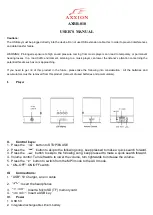
©Copyright AMKUS Rescue Systems 2020-2021
18
LAP-012 October 7, 2021 Rev02
11.0 ROUTINE MAINTENANCE
Obtain appropriate level service technician training before servicing AMKUS Rescue Systems equipment. For more information contact
your local AMKUS Rescue Systems dealer about service levels and training courses.
11.1 HYDRAULIC PUMP
Normally, you will have a maintenance agreement for your system with your local dealer. However, if you have decided to service the
equipment yourself, please review the following instructions carefully.
Check the hydraulic fluid level sight gage after every use. Fluid should be “clear-gold”. Cloudy, milky, brownish, or smelly fluid indicates
contamination. Contact your local dealer or AMKUS Rescue Systems. A noticeable drop in fluid level indicates fluid loss. Investigate and
correct the cause of loss, add MV1 hydraulic fluid as needed. Change oil filter after every 100 hours of pump operation. Change
hydraulic fluid after every 300 hours of pump operation.
The rated hydraulic pressure at maximum output is 10,500 psi +- 500 psi (724 bar+-34 bar). Verify performance by periodic testing using
a pressure gauge. If performance falls outside of this range, contact your local dealer or AMKUS Rescue Systems.
11.1.1 OIL CHANGE PROCEDURE
1. Remove the fill plug/vent cap.
2. Place a drain pan under the drain plug.
3. Unscrew the drain plug being careful not to lose it.
4. Allow the hydraulic fluid to drain completely.
5. Clean and reinstall the drain plug.
6. Replace the filter.
7. Fill the hydraulic fluid reservoir with new AMKUS MV1 fluid.
8. Reinstall the fill plug/vent cap.
9. Cycle rescue tools several times to purge air from the hydraulic hoses.
11.2 HYDRAULIC HOSES
After each use, hoses should be wiped clean with a light cleaner such as Simple Green
®
. Inspect hoses for damage to the rubber outer
cover. Damage which exposes the wire braided reinforcement subjects the wire to corrosion and may weaken the hose.
11.3 COUPLINGS
Use care when making hydraulic connections by avoiding dirt, sand, and water puddles at the scene. Even with care, residual oils on the
moving parts will gradually accumulate dirt and grit making connections difficult. Couplings and dust caps can be periodically cleaned
using an automotive type aerosol solvent de-greaser. Avoid water-based cleaning products. Apply a light spray lube (automotive, lock, or
gun type) to keep the collars moving easily. Avoid covering a clean coupling with a dirty dust cap.
WARNING
Service technicians bear responsibility for ensuring use of appropriate protective clothing and
equipment. The chosen protective clothing and equipment must provide protection from potential
hazards users may encounter while servicing or operating AMKUS rescue tools. Requirements for
protective clothing and equipment are determined by the Authority Having Jurisdiction (AHJ).
NOTICE
DO NOT ATTEMPT TO ADJUST THE INTERNAL PRESSURE RELIEF SETTING! Pressure relief valves
are NOT user serviceable. User adjustment is a misuse of this equipment.



































